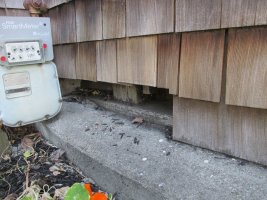conarb
REGISTERED
This is a Loose Tiger question, but others may be able to help. On another forum a young contractor posted this picture and question, the facts are apparently that he is doing unrelated work on the property and the owner wants him to patch the shingles, he wants to know how to patch the shingles (I know, dumb question).

I pointed out that the shingles were the least of the problems, that the location of the meter was a violation of the meter location and posted the PG&E Greenbook showing the PG&E location requirements and suggested calling the PG&E representative, the service is free. For some reason he does not want to call them, I assume because he doesn't want to move the meter. I then pointed out other possible problems like I see no bonding at the meter and asked him to post a larger picture showing the regulator and any existing bonding and driven ground rods, pointing out that when he has a building inspection of any type the inspector will want to see these things. He refuses to call PG&E, or an inspector, or even post a larger picture, this makes me wonder if he's even getting a permit and everybody else is painting me as a troublemaker.
One guy properly pointed out that PG&E has recently installed a Smart Meter so they have accepted the existing illegal location, my response was that PG&E had an unlicensed subcontractor running around slapping millions of those smart meters in ignoring PG&E regulations and codes (I was home when they did mine and I talked to the guy). A guy from San Francisco pointed out that bonding can occur inside the garage at the water heater, I think San Francisco still seriously amends their codes due to tehir unusual soils and zero lot line conditions. But is bonding allowed at areas other than the meter?
This really pisses an old guy like me off, these young contractors that neither own nor have ever seen a utility Greeenbook, and who think regulations are something to avoid if you can.
So my question is, if a Tiger type inspector came across this what could he see from this inadequate picture? If the Tiger were to inspect work in another area of the old home would he even look at something like this? What about all these Smart Meter installations, should they trigger code compliance or are they exempt like allowing solar panels to be installed without engineering the roof to carry the additional weight and wind loads? This is to say nothing about fast tracking permits for solar panels while the rest of us get shove further down the line on the permit wait-list. Are "saving the planet" installations like solar panels and Smart Meters exempt from and take precedence over the traditional health and safety requirements of the codes?

I pointed out that the shingles were the least of the problems, that the location of the meter was a violation of the meter location and posted the PG&E Greenbook showing the PG&E location requirements and suggested calling the PG&E representative, the service is free. For some reason he does not want to call them, I assume because he doesn't want to move the meter. I then pointed out other possible problems like I see no bonding at the meter and asked him to post a larger picture showing the regulator and any existing bonding and driven ground rods, pointing out that when he has a building inspection of any type the inspector will want to see these things. He refuses to call PG&E, or an inspector, or even post a larger picture, this makes me wonder if he's even getting a permit and everybody else is painting me as a troublemaker.
One guy properly pointed out that PG&E has recently installed a Smart Meter so they have accepted the existing illegal location, my response was that PG&E had an unlicensed subcontractor running around slapping millions of those smart meters in ignoring PG&E regulations and codes (I was home when they did mine and I talked to the guy). A guy from San Francisco pointed out that bonding can occur inside the garage at the water heater, I think San Francisco still seriously amends their codes due to tehir unusual soils and zero lot line conditions. But is bonding allowed at areas other than the meter?
This really pisses an old guy like me off, these young contractors that neither own nor have ever seen a utility Greeenbook, and who think regulations are something to avoid if you can.
So my question is, if a Tiger type inspector came across this what could he see from this inadequate picture? If the Tiger were to inspect work in another area of the old home would he even look at something like this? What about all these Smart Meter installations, should they trigger code compliance or are they exempt like allowing solar panels to be installed without engineering the roof to carry the additional weight and wind loads? This is to say nothing about fast tracking permits for solar panels while the rest of us get shove further down the line on the permit wait-list. Are "saving the planet" installations like solar panels and Smart Meters exempt from and take precedence over the traditional health and safety requirements of the codes?
